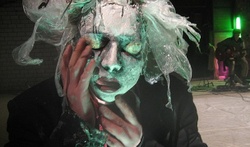DIE BLUMEN DES BÖSEN
In the organizer's words:
THE FLOWERS OF EVIL
20 out of 100 poems by Charles Baudelaire
This title alone! A panorama on the precipice.
While entire districts in Paris are being destroyed to make room for the wide boulevards, while glass passageways replace the medieval alleyways and gas lanterns blur the boundary between day and night, Charles Baudelaire begins a revolution in literature. The fusion of the seemingly incompatible - themes of the abysmal, the extreme and ennui captured and linguistically condensed in the classic form of romantic love poetry - was the first step on the road to modernity. And no sooner had Baudelaire's first work, Les Fleurs du Mal, been published in 1857 than a criminal trial followed with accusations of amorality and blasphemy. Some poems were censored and all printed copies were confiscated.
Baudelaire's radical subjectivity and incessant search for the moment, as well as the presumption of beauty precisely where no one suspects it, open up the space for a transposition into the play of figures. The texts are permeated by the phenomenon of synaesthesia, an interweaving of sensory perceptions. The production follows this trail in the interplay of figure, voice and music and allows the iridescent beauty of the abysmal to shine through. Every encounter with the flowers of evil is like entering a labyrinth. The familiar makes a new and irritating appearance. It is at times "terrifying and grandiose for everyone." (Marcel Proust).
For these Flowers of Evil, a series of individual recordings have been made by various narrators in French, German and English. The production follows on from the first joint exploration of Baudelaire's work - SPLEEN (2006) - by the puppet theater Wilde & Vogel with director Hendrik Mannes.
Director: Hendrik Mannes
Dramaturgy, co-director: Antonia Christl
Puppet design, play, stage: Michael Vogel
Live music: Charlotte Wilde
Voices (recordings): Lilith Stangenberg, Ilka Schönbein, Barbara Nüsse, Bianca Casady, Nadia Genet, Agnès Limbos, Neysa Barnett, Gabriella Crispino, Johanna Hähner, Orakle Ngoy and Rickie Lee Jones.
Location
Organizer | Ensemble














